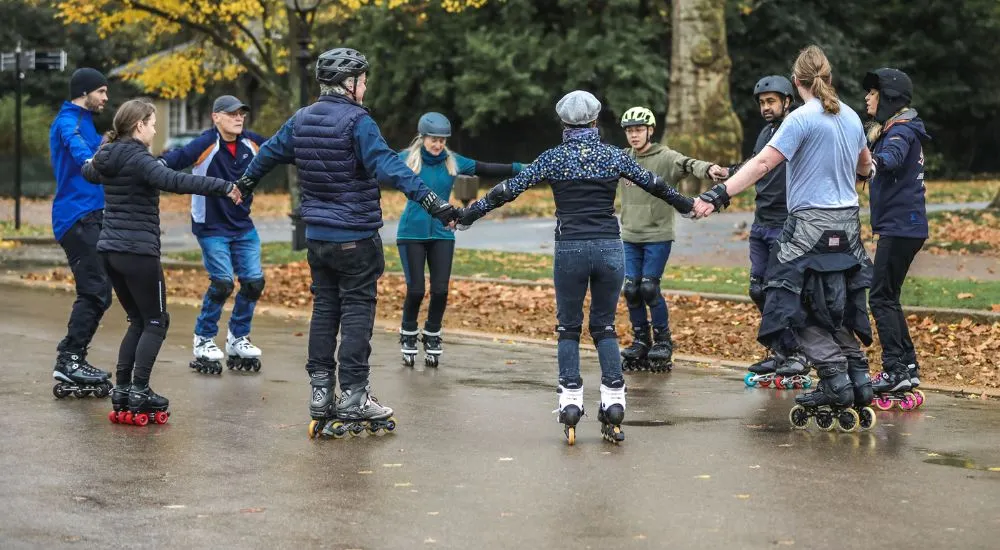If you are about to face your first skating winter, then welcome! You are a true skater if colder weather hasn’t put you off.
There are some advantages to skating through the winter, namely most skate spaces are much quieter without the summer crowds and this allows for more SPACE to those who remain.
Imagine having better quality practice time in winter. Colder temperatures mean we tend to keep moving in winter, stop and chat a bit less and ultimately are more focussed on our skating. Imagine emerging in the spring a different, more accomplished, confident skater?
Inline skating in winter can be a fun and exhilarating activity, but it does come with its unique set of challenges and considerations in colder, wintery weather.

Here are some ideas and tips to help you enjoy winter inline skating safely:
Choose the Right Gear:
- Wear proper winter attire, including a warm jacket, gloves, and a hat.
- Layer your clothing to stay comfortable in changing temperatures.
- Consider using rain wheels when wet.
Select the Right Location:
- Look for wet or damp surfaces and reduce speed significantly and avoid any skill using inside or outside edges. Different surfaces dry faster than others. Beware of variations. Opt for dry surfaces whenever possible.
- Look for paved paths or trails that are regularly cleared of snow and ice. Opt for familiar routes rather than unknown ones.
- Avoid street skating (unless you are already an experienced urban skater). Slippery roads can be dangerous for skating.
Check Weather Conditions:
- Be aware of weather conditions, including temperature, wind, and precipitation, before heading out.
- Avoid skating when its extremely cold or during snowfall, as it can make skating hazardous.

Ice and Snow Awareness:
- Be cautious of icy patches, and watch for black ice, which is nearly
- invisible and extremely slippery.
- Use indoor rink options if available.
Maintain Your Skates:
- Keep your skates clean and lubricated, especially the bearings, to
prevent them from freezing. - Check your wheels and brakes regularly, and ensure they are in good
working condition.
Proper Technique:
- Adjust your skating technique to accommodate potentially wet, slippery
conditions. Take shorter strides, and focus on balance and stability
using the Scissor position and avoid excessive edging (if damp). - Avoid skating when surfaces are damp/wet if you know you feel
anxious. Choose dry days to skate. - Practice stopping and turning (when dry) to improve your control.
Stay Visible:
Days are shorter in winter, and visibility can be reduced due to early darkness. Wear reflective clothing or accessories and use lights to make yourself visible to others.
Carry Essentials:
- Pack essentials like a cell phone, ID, and some money in a waterproof
pouch or bag in case of an emergency. - Bring a first-aid kit, especially if you’re skating in remote areas.
Skating Buddy:
Skating with a friend or in a group is safer, as you can help each other in case of an emergency. But choose your skating routes carefully. All members of the group should have the skills necessary to safely complete the chosen route.
Warm-Up and Cool Down:

Have Fun:
Enjoy the unique beauty of winter while skating. The crisp air, perhaps snow-covered scenery, and the exhilaration of gliding on skates can make for a memorable experience.
Lunchtime Skating?
Consider skating in the middle of the day around lunchtime even if it’s for a quick 30-45 minute session. This should be close to where you work and can regularly give you valuable exercise and practice time that could be structured with different skills on each day to keep things fun.
You don’t need a huge amount of space. People often look for large spaces for skating and when they can’t find any they give up. What about a long narrow space, like along the side of a building? You can skate in one direction then stop and turn around. What is important here is that the length is sufficient. But this provides LOTS of stopping opportunities….
Are there any parking facilities you can use? Smooth area in front of shops nearby? A local park? Start looking around your work area with those ideas in mind.
Skating at the weekend feels even more beneficial in winter when we’re usually indoors a lot more of the time. Try to leave one ‘chunk’ of weekend time free for skating and check the weather in case this chunk needs moving from Saturday to Sunday or vice versa.
Remember that safety should always be a top priority when inline skating in winter. Stay informed about local weather conditions and take precautions to ensure a safe and enjoyable skating experience. Don’t let the winter take your skating away from you.
If you’d like some structured practice to guide your skating this winter, check out the “How to Skate” online course series. Each lesson contains various exercise drills that can be studied, copied & mastered progressively over time.
Check the skills contained in each of the 3 level courses and test them absolutely free.
https://skatefresh.com/product/how-to-skate-beginner-level-full-course/
https://skatefresh.com/product/how-to-skate-intermediate-level-full-course/
https://skatefresh.com/product/how-to-skate-advanced-level-full-course/

